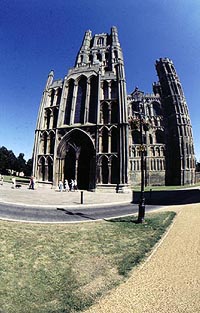Wide-angle photography technique
Words and Pictures Heather Powell
Wide-angle lenses have a focal length of 35mm or less and offer plenty of potential. Within this category there are sub sections:
6mm 15mm Fisheye
14mm 21mm Ultra Wide Angle
24mm 35mm Wide Angle
Generally many photographers will purchase a wide-angle lens, normally around 28mm, because they want more coverage in the picture. Its a popular choice for the landscape enthusiasts and in this situation; the dramatic effects that are possible with such lenses are not always obvious.
Go wider and you will start to notice a difference. 24mm tends to be a good starting point for this area of photography without being too radical. The effects that can be obtained with such lenses can provide images not to everyones taste.
A 24mm lens allows you to make tentative step into wide-angle photography before deciding if it is for you or not and could save you from some expensive mistakes. At 24mm you will start to see major changes to you images. With an angle of view in the region of 94 degrees, it is at this point that images starts to show the signs of curving. The increase in coverage compared to a 50mm lens is four times greater. As the focal length gets shorter, the distortions become more pronounced and obvious. By the time you reach 15mm, you are into the realms of fisheye lenses.
The main characteristic of a fisheye lens is that it creates major distortion. This can be broken down into two types, circular or full frame images. A circular image generally tends to happen at the widest setting (6mm) and gives as close to as possible a 360-degree image. Full frame is where the image displays extreme features of a wide-angle lens while incorporating properties common to fisheye lenses. No matter what the subject matter, the image will attract attention. Of all the lenses available, fisheyes tend to be one of the least practical and generally less important lenses. On the flip side they can be great fun to work with, creating visually exciting effects that often captivate people.
Perspective is affected by viewpoint and in photography terms, it is also dependant on the degree of enlargement and the viewing distance of the print. In order to preserve natural perspective, an image should be enlarged in proportion to the chosen focal length.
To get the most exciting images from your wide-angle lens, whatever the focal length, this theory should be ignored. Whats the point of having a lens capable of producing such exciting images?
| Landscape photography is where wide-angles tend to be most commonly used. This is down to their increased field of vision. Generally images appear normal but it is still possible to achieve some perspective distortion. This is illustrated by the image of the canal bank. The foreground has an uncharacteristic curve to it and the foreground features are more enhanced. It is also show in the other landscape image shown. | 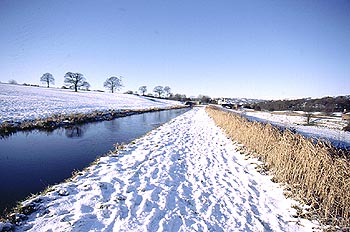 |
| This image illustrates linear distortion often common with wide-angle lenses. The lines of the image disappear into the distance, almost to a point. In the foreground, footprints in the snow appear large. |
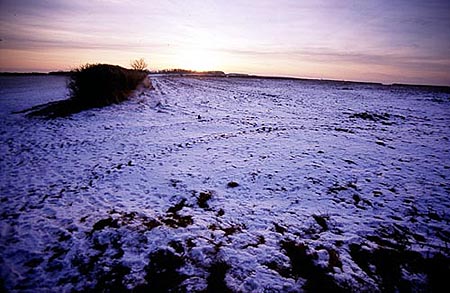
The foreground of this image appears to have a curve to it, with objects appearing much bigger than those in the distance.
The two images below show how the lens has exaggerated the scale of the objects close to the lens, which becomes more prominent as the focal length decreases. The black & white image was shot using a 20mm lens while the colour image of the cathedral was shot using a 14mm lens. The images appear almost 3D, compared to images shot on longer focal lengths, which tend to flatten a shot.
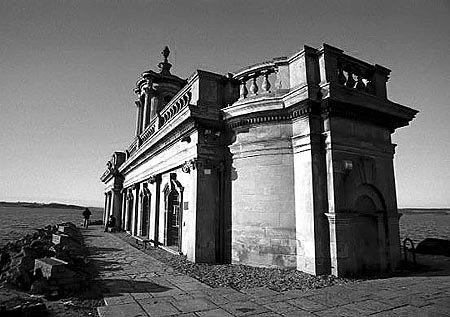
| Above: Perspective distortion is evident in this image, with the front of the building appearing much larger than the rest of it. The windows on the side of the building get smaller the further they are from the lens. Converging verticals is a common photographic problem and it is more pronounced when using wide-angle lenses. This is also demonstrated in both of the images. It is caused when a camera is tilted upward to include the top of the building. As the camera is closer to the base of the building, that appears bigger and the vertical lines of the image bend inwards toward the top of the image. In the images illustrated, both buildings have spires but it is still obvious what has happened. This can be corrected by using a perspective control lens, which has movable elements, to correct the converging verticals.
Right: Converging vertical are obvious on this image. |
|
| Another practical use for using a wide-angle lens is for shooting in confined spaces. As with landscape photography, the distortion is not necessarily as obvious in the image and this is demonstrated by the picture below. | 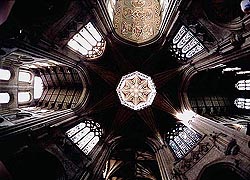 |
| This was shot inside a cathedral. By using a 14mm lens, it was possible to record a lot of the decorated ceiling. |
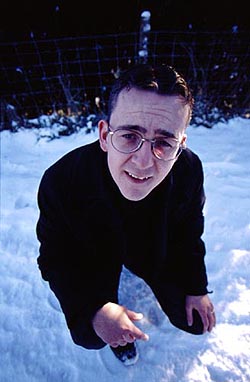 One of the most unexpected areas where a wide-angle lens can be used is portraiture. In terms of 35mm photography, 80 - 90mm tends to be classed as a normal portrait lens, whereas shorter focal length lenses tend to distort features. With a high viewpoint features such as the forehead, glasses and nose can appear grossly exaggerated. The hands, feet and lower part of the body can appear much smaller in relation to other features. When shooting upwards, this trend is reversed, with models having huge feet and tiny heads. The wide-angle lens opens up a huge range of unusual portrait possibilities. Some people tend to find that the novelty of wide-angle portraits can wear off, but it does open up a whole new world to this area of photography, and how images can be interpreted.
One of the most unexpected areas where a wide-angle lens can be used is portraiture. In terms of 35mm photography, 80 - 90mm tends to be classed as a normal portrait lens, whereas shorter focal length lenses tend to distort features. With a high viewpoint features such as the forehead, glasses and nose can appear grossly exaggerated. The hands, feet and lower part of the body can appear much smaller in relation to other features. When shooting upwards, this trend is reversed, with models having huge feet and tiny heads. The wide-angle lens opens up a huge range of unusual portrait possibilities. Some people tend to find that the novelty of wide-angle portraits can wear off, but it does open up a whole new world to this area of photography, and how images can be interpreted.
A high viewpoint has resulted in an exaggerated facial features while the rest of the body appears small in comparison. Another example of perspective distortion.
Wide-angle lenses have many different uses and there is no limit as to the effects that can be achieved. Ultimately the only limits are those of your imagination and love them or hate them, wide-angle lenses are an important part of photography.
Add your message
Please login here or if you've not registered, you can register here. Registering is safe, quick and free.
photodo Stats
428 MTF tests
74 in-depth photodo reviews
100+ users join each day
Help the lens community by reviewing or rating a lens today via our lens search
Latest Lens Reviews
- Chinon 28mm f/2.8 Vintage Lens Review
- Canon EF 70-200mm f/4L IS II USM Lens Review
- Samyang AF 85mm f/1.4 EF Review
- Sigma 70mm f/2.8 DG Macro Art Review
- Samyang AF 24mm f/2.8 FE Review
- Meike 50mm f/1.7 Review
- Tamron 70-210mm f/4 Di VC USD Review
- Lensbaby Burnside 35mm f/2.8 Review
- Asahi Super Takumar 50mm f/1.4 Review
- Asahi Super-Multi-Coated Takumar 135mm f/3.5 Review
